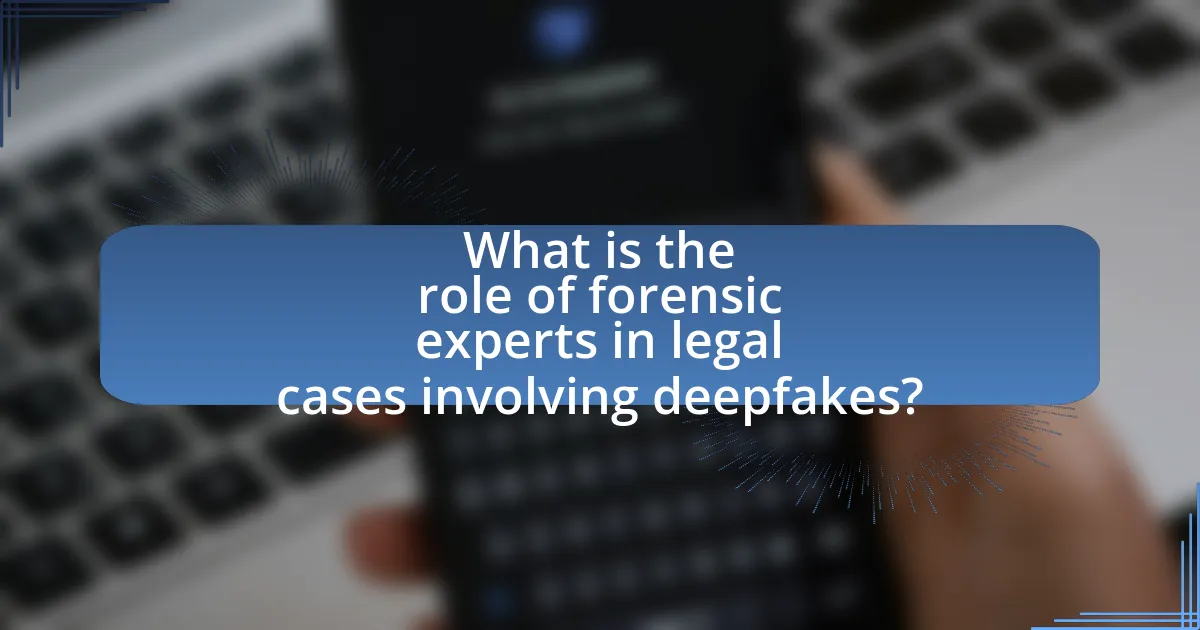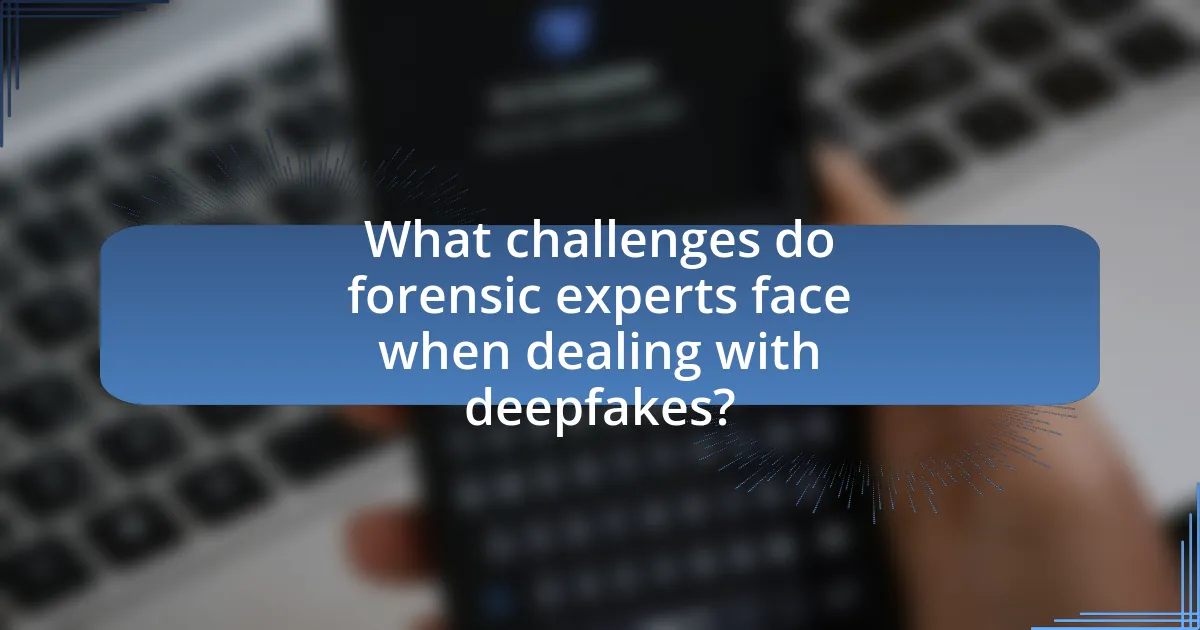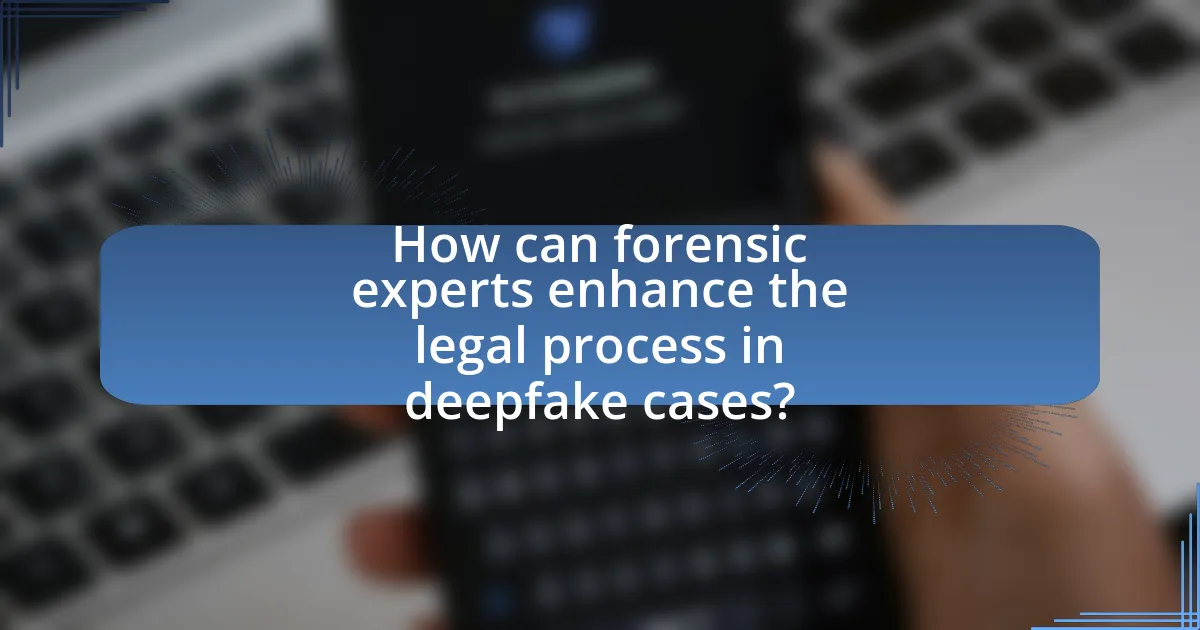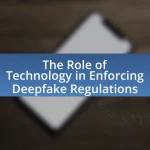Forensic experts play a vital role in legal cases involving deepfakes by employing advanced techniques to analyze digital content for authenticity and manipulation. They utilize methods such as digital forensics, machine learning algorithms, and visual analysis to detect inconsistencies in videos and images, which can significantly influence court outcomes. The article explores how these experts identify deepfakes, the effectiveness of their techniques in legal contexts, the challenges they face, and the ethical considerations surrounding their work. Additionally, it discusses the legal implications of deepfake technology and the best practices forensic experts should follow to ensure the integrity of their findings in court.

What is the role of forensic experts in legal cases involving deepfakes?
Forensic experts play a crucial role in legal cases involving deepfakes by analyzing digital content to determine authenticity and identify manipulations. They utilize advanced techniques such as digital forensics, image analysis, and machine learning algorithms to detect alterations in videos or images. For instance, forensic experts can examine pixel inconsistencies, audio mismatches, and metadata discrepancies to provide evidence in court. Their findings can significantly influence the outcome of legal proceedings, as courts increasingly rely on expert testimony to assess the validity of digital evidence.
How do forensic experts identify deepfakes in legal contexts?
Forensic experts identify deepfakes in legal contexts by employing a combination of advanced technological tools and analytical techniques. These experts utilize algorithms that analyze inconsistencies in video and audio data, such as unnatural facial movements, irregular blinking patterns, and mismatched audio-visual synchronization. For instance, techniques like digital forensics and machine learning models can detect artifacts that are often present in manipulated media, which are not typically found in authentic recordings. Additionally, forensic experts may compare the suspect media against known authentic sources to identify discrepancies. Studies have shown that these methods can achieve high accuracy rates in distinguishing deepfakes from genuine content, thereby providing reliable evidence in legal proceedings.
What techniques do forensic experts use to detect deepfakes?
Forensic experts use a variety of techniques to detect deepfakes, including digital forensics, machine learning algorithms, and visual analysis. Digital forensics involves examining the metadata of a video or image to identify inconsistencies that may indicate manipulation. Machine learning algorithms are trained to recognize patterns typical of deepfake technology, such as unnatural facial movements or mismatched audio and visual cues. Visual analysis focuses on detecting artifacts like blurring around the edges of faces or irregular lighting that can reveal alterations. These methods are supported by studies showing that deepfake detection accuracy improves with advanced algorithms and forensic techniques, making them essential tools in legal cases involving manipulated media.
How effective are these techniques in court?
The effectiveness of forensic techniques in court regarding deepfakes is significant, as they provide critical evidence for identifying manipulated media. Forensic experts utilize advanced methods such as digital forensics, machine learning algorithms, and visual analysis to detect inconsistencies in deepfake videos and images. Studies have shown that these techniques can achieve detection rates exceeding 90% in controlled environments, which enhances their reliability in legal proceedings. For instance, research published in the journal “IEEE Transactions on Information Forensics and Security” demonstrates the efficacy of these methods in distinguishing authentic content from deepfakes, thereby supporting their use as credible evidence in court.
Why is the involvement of forensic experts crucial in deepfake cases?
The involvement of forensic experts is crucial in deepfake cases because they possess specialized skills and tools necessary to detect and analyze manipulated media. Forensic experts utilize advanced techniques such as digital forensics, machine learning algorithms, and visual analysis to identify inconsistencies and artifacts that indicate a deepfake. Their expertise is essential for providing credible evidence in legal proceedings, as demonstrated by studies showing that forensic analysis can significantly improve the accuracy of deepfake detection, thereby aiding in the prosecution of fraud and defamation cases.
What legal implications arise from deepfake technology?
Deepfake technology raises significant legal implications, primarily concerning issues of identity theft, defamation, and privacy violations. The creation and distribution of deepfakes can lead to unauthorized use of an individual’s likeness, which may violate laws related to intellectual property and personal rights. For instance, in the United States, the use of someone’s image without consent can result in civil lawsuits under tort law, specifically for invasion of privacy or misappropriation of likeness. Additionally, deepfakes can be used to spread misinformation, potentially leading to criminal charges under laws against fraud or election interference. The legal landscape is evolving, with some jurisdictions considering specific legislation to address the unique challenges posed by deepfakes, highlighting the urgent need for legal frameworks that can effectively manage these emerging technologies.
How can forensic experts help establish authenticity in evidence?
Forensic experts establish authenticity in evidence by employing advanced techniques such as digital forensics, image analysis, and audio verification. These specialists analyze the metadata of digital files to confirm their origin and integrity, ensuring that the evidence has not been tampered with. For instance, forensic analysis can detect alterations in video or audio files, revealing inconsistencies that indicate manipulation. Additionally, forensic experts utilize software tools to assess the quality and characteristics of the evidence, comparing it against known authentic samples. This rigorous examination process is crucial in legal cases involving deepfakes, where the authenticity of evidence can significantly impact the outcome of a case.

What challenges do forensic experts face when dealing with deepfakes?
Forensic experts face significant challenges when dealing with deepfakes, primarily due to the rapid advancement of deepfake technology that complicates detection. The sophistication of deepfake algorithms, such as Generative Adversarial Networks (GANs), allows for the creation of highly realistic fake videos and audio, making it difficult for forensic experts to distinguish between authentic and manipulated content. Additionally, the lack of standardized tools and methodologies for deepfake detection further complicates forensic analysis, as experts must rely on evolving techniques that may not be universally accepted or effective. Furthermore, the legal implications of deepfakes, including issues of consent and copyright, add layers of complexity to forensic investigations, as experts must navigate both technical and legal challenges in their assessments.
How does the evolving nature of deepfake technology impact forensic analysis?
The evolving nature of deepfake technology significantly complicates forensic analysis by increasing the difficulty of detecting manipulated media. As deepfake algorithms become more sophisticated, traditional forensic techniques, such as pixel analysis and audio forensics, struggle to identify alterations, leading to a higher risk of misidentification in legal contexts. For instance, a study published in 2020 by the University of California, Berkeley, demonstrated that state-of-the-art deepfake detection methods had a detection accuracy of only 65%, highlighting the challenges forensic experts face. Consequently, forensic analysts must continuously adapt their methodologies and incorporate advanced machine learning techniques to keep pace with the rapid advancements in deepfake technology, ensuring the integrity of evidence in legal proceedings.
What are the limitations of current forensic methods for deepfake detection?
Current forensic methods for deepfake detection face several limitations, including the inability to consistently identify subtle manipulations and the rapid evolution of deepfake technology. These methods often rely on specific artifacts or inconsistencies that may not be present in all deepfakes, leading to false negatives. Additionally, many detection tools struggle with high-quality deepfakes that closely mimic real footage, making it challenging to differentiate between genuine and altered content. Research indicates that as deepfake generation techniques improve, existing forensic methods may become increasingly ineffective, highlighting the need for continuous advancements in detection technologies.
How do forensic experts stay updated with advancements in deepfake technology?
Forensic experts stay updated with advancements in deepfake technology through continuous education, participation in specialized training programs, and engagement with professional organizations. These experts often attend conferences, workshops, and seminars focused on digital forensics and artificial intelligence, which provide insights into the latest techniques and tools for detecting deepfakes. Additionally, they follow relevant academic journals and publications, such as the Journal of Digital Forensics, Security and Law, which publish peer-reviewed research on emerging technologies and methodologies. This commitment to ongoing learning ensures that forensic experts remain proficient in identifying and analyzing deepfake content effectively.
What ethical considerations must forensic experts navigate in deepfake cases?
Forensic experts must navigate several ethical considerations in deepfake cases, primarily focusing on the accuracy of their analyses and the potential consequences of their findings. Ensuring the integrity of evidence is crucial, as misidentifying a deepfake can lead to wrongful accusations or legal repercussions for innocent individuals. Additionally, forensic experts must consider the implications of their work on privacy rights, as deepfakes can be used to manipulate personal images without consent, raising ethical concerns about exploitation and harm. Furthermore, the potential for deepfakes to influence public opinion or legal outcomes necessitates a commitment to transparency and objectivity in their methodologies. These ethical considerations are underscored by the increasing prevalence of deepfake technology, which has been documented to create realistic but false representations, thereby complicating the landscape of digital evidence in legal contexts.
How do forensic experts balance privacy concerns with legal obligations?
Forensic experts balance privacy concerns with legal obligations by adhering to established legal frameworks while implementing best practices for data handling. They operate under laws such as the Fourth Amendment, which protects against unreasonable searches and seizures, ensuring that any evidence collected respects individual privacy rights. Additionally, forensic experts utilize anonymization techniques and data minimization strategies to limit exposure of personal information during investigations. This dual approach allows them to fulfill their legal responsibilities while safeguarding the privacy of individuals involved, as evidenced by guidelines from organizations like the International Association for Identification, which emphasize ethical standards in forensic practices.
What role does consent play in the analysis of deepfake evidence?
Consent is crucial in the analysis of deepfake evidence as it determines the legality and ethical implications of using such content in legal contexts. When individuals have not given consent for their likeness or voice to be manipulated, the resulting deepfake can infringe on privacy rights and intellectual property laws, potentially rendering the evidence inadmissible in court. Forensic experts must assess whether consent was obtained to evaluate the authenticity and legality of the deepfake, as unauthorized use can lead to significant legal repercussions, including civil lawsuits and criminal charges.

How can forensic experts enhance the legal process in deepfake cases?
Forensic experts can enhance the legal process in deepfake cases by providing specialized analysis that identifies the authenticity of digital content. Their expertise allows them to detect manipulations in videos or audio recordings through advanced techniques such as digital forensics, machine learning algorithms, and visual artifact analysis. For instance, a study published in the journal “IEEE Transactions on Information Forensics and Security” demonstrates that forensic analysis can reveal inconsistencies in pixel patterns and audio waveforms, which are indicative of deepfake technology. This scientific evidence can be crucial in court, as it helps establish the credibility of the evidence presented, thereby supporting legal arguments and aiding in the prosecution or defense of cases involving deepfakes.
What best practices should forensic experts follow when analyzing deepfakes?
Forensic experts should follow a systematic approach when analyzing deepfakes, which includes verifying the authenticity of the media, utilizing specialized software tools for detection, and maintaining a detailed chain of custody for evidence. Verifying authenticity involves cross-referencing the media with known legitimate sources to identify discrepancies. Specialized software tools, such as deepfake detection algorithms, can analyze inconsistencies in pixel data and audio-visual synchronization, providing objective evidence of manipulation. Maintaining a detailed chain of custody ensures that the evidence remains admissible in court, preserving its integrity throughout the forensic process. These practices are essential for producing reliable and credible findings in legal cases involving deepfakes.
How can forensic experts ensure the integrity of their findings?
Forensic experts can ensure the integrity of their findings by adhering to standardized protocols and employing rigorous validation techniques. These experts utilize established methodologies, such as chain of custody procedures, to maintain the authenticity of evidence from collection to analysis. Additionally, they often implement peer review processes and utilize advanced forensic tools that have been validated through scientific research, ensuring that their findings are reliable and reproducible. For instance, the use of software that has undergone extensive testing in forensic settings enhances the credibility of the results obtained.
What protocols should be established for presenting deepfake evidence in court?
Protocols for presenting deepfake evidence in court should include rigorous verification processes, expert testimony, and clear documentation of the evidence chain. Verification processes must involve forensic analysis to confirm the authenticity of the deepfake, utilizing tools that can detect manipulation, such as digital forensics software. Expert testimony from forensic specialists is essential to explain the technical aspects of the deepfake and its implications for the case, ensuring that the court understands the evidence’s reliability. Additionally, maintaining a clear documentation chain is crucial to establish the provenance of the evidence, detailing how it was collected, analyzed, and presented, which aligns with legal standards for admissibility. These protocols are vital to uphold the integrity of the judicial process in cases involving deepfakes.
What resources are available for forensic experts working with deepfakes?
Forensic experts working with deepfakes have access to various resources, including specialized software tools, academic research, and professional organizations. Software tools such as Deepware Scanner and Sensity AI provide capabilities for detecting manipulated media. Academic research, such as studies published in journals like IEEE Transactions on Information Forensics and Security, offers insights into detection methodologies and advancements in deepfake technology. Additionally, organizations like the International Association for Identification (IAI) and the Digital Forensics Research Workshop (DFRWS) provide networking opportunities, training, and resources for professionals in the field. These resources collectively enhance the ability of forensic experts to analyze and address deepfake-related challenges effectively.
How can forensic experts collaborate with legal professionals effectively?
Forensic experts can collaborate effectively with legal professionals by establishing clear communication channels and defining roles early in the legal process. This collaboration is essential in cases involving deepfakes, where forensic experts provide specialized knowledge in digital forensics to analyze evidence and present findings that are comprehensible to legal teams. For instance, forensic experts can assist in identifying the authenticity of digital content, which is crucial for legal arguments. Studies have shown that effective collaboration leads to improved case outcomes, as seen in cases where forensic analysis directly influenced jury decisions.
What training opportunities exist for forensic experts in deepfake detection?
Training opportunities for forensic experts in deepfake detection include specialized workshops, online courses, and certification programs focused on digital forensics and artificial intelligence. Institutions such as the International Association of Computer Investigative Specialists (IACIS) and the Digital Forensics Certification Board (DFCB) offer training that covers the latest techniques in identifying manipulated media. Additionally, universities and organizations like Stanford University and the MIT Media Lab provide courses that delve into machine learning and its application in detecting deepfakes, equipping forensic experts with the necessary skills to analyze and interpret digital evidence effectively.
What practical tips can forensic experts apply in deepfake investigations?
Forensic experts can apply several practical tips in deepfake investigations, including utilizing specialized software for detection, analyzing metadata, and examining inconsistencies in audio and visual elements. Specialized software, such as Deepware Scanner and Sensity AI, can identify manipulated content by analyzing pixel-level anomalies and compression artifacts. Additionally, forensic experts should scrutinize metadata for signs of tampering, such as unusual timestamps or editing history, which can indicate manipulation. Furthermore, experts should look for inconsistencies in facial movements, lip-syncing, and background noise, as these often reveal discrepancies that suggest a deepfake. These methods are supported by research indicating that deepfake detection tools can achieve accuracy rates exceeding 90% in identifying manipulated media.


